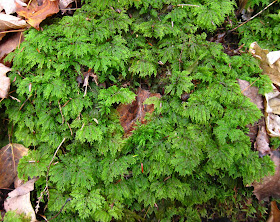Ever since noted botanist Ruth Schottman joined me for a
botanical adventure at Pyramid Lake last July, we've been meaning to return to further explore together this beautiful wilderness lake in the Adirondacks. We finally got there on Monday morning and found we had the whole lake to ourselves, with not another human soul around. Although the day proved too windy for comfortable paddling in our tandem canoe, we were happy enough to leave our boat on shore and set off on a couple of hikes through the woods and around the lake.
Not only is Ruth a delightful hiking companion, she is also a walking encyclopedia of botanical knowledge. We hadn't walked far before she spotted this interesting anomalous clump in an alder along the shore and didn't even have to check a guide to give it a name. This is Taphrina, she promptly told me, an alder gall caused by a fungus that affects just the female flowers.
I knew right away this was going to be fun and that I would learn a lot from my companion. There are so many fascinating phenomena in the woods in every season, adding interest to every walk, even long after the flowering plants have shriveled and died. Most mosses, for example, stay fresh and green all year, including this
Bartramia pomiformis, with its long silky leaves and little brown "pomiform" (apple-shaped) fruiting bodies.
On the other hand, most mushrooms are really ephemeral, disappearing almost as fast as they arise. We were lucky to spot this handsomely studded, somewhat slimy Pholiota clump, sharing its cut-log surface with several other (unidentified) fungi.
Our morning hike took us along a trail that was bordered by huge boulders that were covered with many different kinds of lichens. This aptly named foliose lichen called Toadskin Rock Tripe (
Lasallia papulosa) was sharing its boulder with smooth-skinned rock tripes not visible in this photo.
Although this Dog Lichen (
Peltigera polydactyla) often grows on woody substrates, it can sometimes be found on boulders, too. I have read that it gets its name from having once been used as a (futile!) treatment for rabies in dogs, but I remember its name from the little brown fruiting bodies folded over like dogs' ears. Its dark, almost black, thallus is a clue that this lichen associates with cyanobacteria as well as the fungi and algae that typically constitute all lichens.
I'm going to have to get back to Ruth to see if she can name this red-brown liverwort. It looks similar to the Frullania liverworts that grow on trees, but this was growing on the face of a boulder.
Another liverwort I don't know the name of, this one growing on tree bark and of a bright green color.
As our trail climbed higher and higher above the lake, we soon came to lookout point where we could see the majestic Pharaoh Mountain rising to the south.
Our trail reached its summit in a rocky outcropping where we stood and gazed out at the beauty of the lake and surrounding forests and mountains, all part of the Pharaoh Lake Wilderness Area. How lucky I am to have access to such splendid wilderness, just an hour's drive from my home!
We retraced our steps back to Pyramid Life Center, where we had left our car and our lunch bags. One of the structures that make up the retreat center at Pyramid Lake is this charming little meditation hut right on the water. Here, we could take shelter from the wind and eat our midday meal in comfort while enjoying the view.
After lunch, we set off in another direction, choosing a trail that leads toward Eagle Lake just a mile or so to the east.
Our trail crossed several woodland streams still rushing with water as if it were springtime snowmelt, instead of autumn. I could stand and gaze at such miniature musical waterfalls for a long, long time.
This woodland trail offered abundant sightings of fungi, including whole logs full of Angel's Wings (
Pleurocybella porrigens), a good edible if we had found it a day or so earlier.
Another good edible is Late Fall Oyster Mushroom (Panellus serotinus), which was still fresh and firm when we found it. I hadn't planned on cooking dinner that night (it takes a long slow stewing), or I might have collected a mess to bring home.
We were struck by the beautiful rich red-brown tops of these shelf fungi, possibly Artist's Conk (
Ganoderma applanatum).
Here's the smooth, white underside of that Artist's Conk, with a flesh that is easily bruised. Detailed drawings can be etched into that flesh, which will retain those drawings permanently after drying.
Boy, I don't know what this one is! At first I thought it was Ochre Spreading Tooth, but on closer inspection that orange stuff doesn't look like teeth, and I can't find anything in my mushroom books that fits that description. Whatever it is, it was quite colorful.
I remember finding Ravenel's Stinkhorn (
Phallus ravenelii) along this same trail last year, so I wasn't surprised to find it again, surrounded by flies attracted to its fetid odor.
Such a lush bright-green patch of feathery moss! It looked familiar, but I couldn't remember its name, although Ruth knew it right away. This is Stair-step Moss (
Hylocomium splendens), a boreal species so named for its habit of growing a single layer every year, the new growth sprouting from the middle of the old.
Yet another liverwort, this one decorating a rotting log with its pretty bright-green branchings. At first I thought it was a moss, but Ruth corrected me. A closer inspection with a magnifier revealed it to be the leafy liverwort
Lophocolea bidentata.
Here's a view as close as I could get with my camera. If you click on this photo, you might see the two-teethed leaves that give this liverwort its specific name of
bidentata.































































